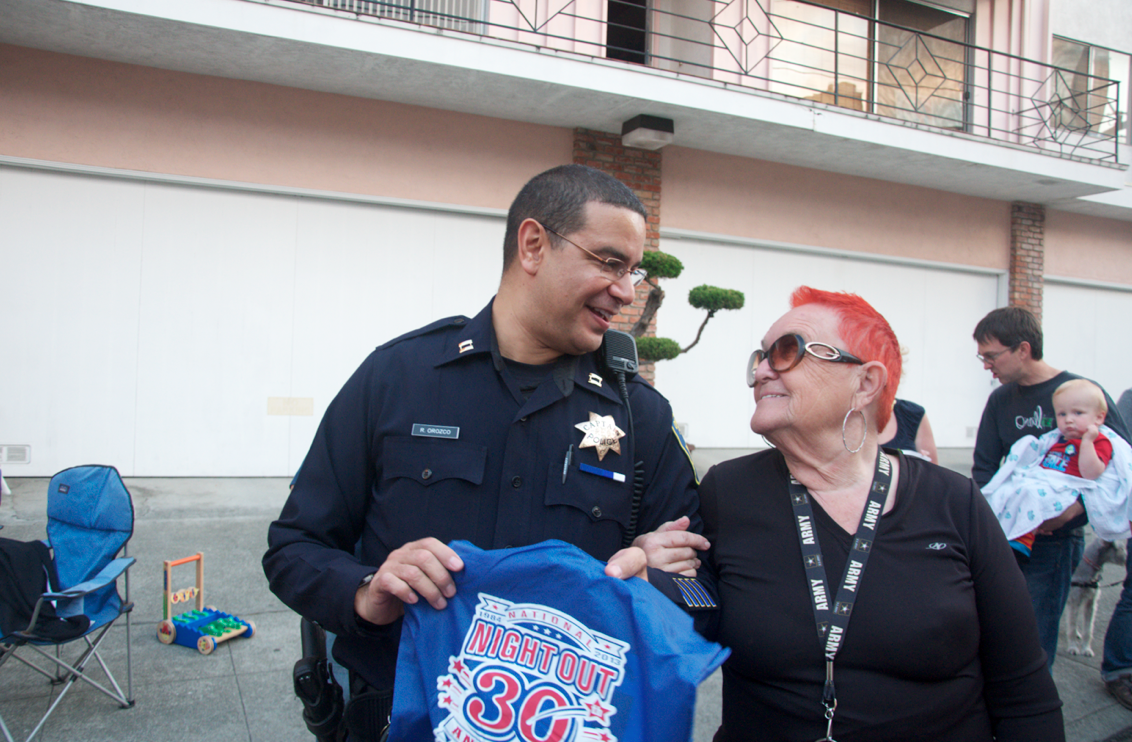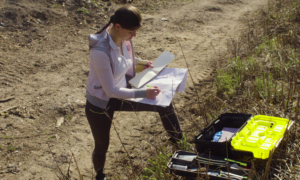
At a National Night Out event in Chicago, Ill., Frances Valadez, Commander of the 14th district of the Chicago Police Dept., stated, “I believe that a lot of kids that are here this is their first contact with the police. Hopefully it’s positive and they remember it and they don’t fear the police … we don’t want to be the bad guys … we want to help kids with their goals in life.”
For three decades National Night Out has encouraged neighborhoods to host block parties, ice cream socials, and other outdoor events to build “neighborhood camaraderie and send a message to criminals letting them know that neighborhoods are organized and fighting back,” according to the organization’s website.
Billed as “the nation’s night out against crime,” National Night Out operates under the idea that when neighbors know each other they can look out for each other to prevent and deter crime.
In Oakland, a “Rare” Community Event
According to the organization, today NNO involves more than 37 million people from 15,000 communities in the United States. In Oakland, Calif., alone there were 670 block parties registered with the city. Felicia Verdin, Community Programs Supervisor for the city, said that the main goal of the event in Oakland is to build police and community relationships. It is important, she stated, for the community to “get to know the police in a more friendly and informative way, and for the police to get to know the community.” This is paramount to both solving crime and supporting the community, Verdin posited, because if the police “know people informally [they are] more likely to treat people with respect and dignity.”
In the Fruitvale district of Oakland, at the blocked-off intersection of International Blvd., and 31st street, children vaulted off the walls of a bounce house, community members lined up to load their plates with fried chicken and a band jammed.
Ricardo E. Orozco, Captain of Police, was one of more than 200 city personnel traversing Oakland to attend the NNO block parties. Orozco has been with the city police force for 26 years and has attended over a decade’s worth of NNO events. One key part of the event, Orozco stated, was bringing out young officers to connect with the community. In addition, he stated, “It brings neighbors out and makes neighborhoods safer by knowing who is who and helping people put a name with a face, someone you can contact in case of an emergency.”
Bonney Hartley, 31, an Oakland resident and block party organizer, said that her organization went door-to-door around their block to invite residents and merchants to the event.
“Any opportunity to broaden beyond our clients — to meet more of our neighbors — is important.” Especially, Hartley noted, since it’s “rare” to have community events in their neighborhood in East Oakland.
New Yorkers Note Police and Community Relations

Photo by Eli Chen. Community members chatting at a National Night Out event at Astoria Park in Queens, N.Y.
Meanwhile, at Astoria Park in Queens, N.Y., community members gathered on a sunny lawn alongside the waterfront of the East River to celebrate the event. Pop music blared as police officers barbecued hot dogs and children with face paint played carnival games. Antonio Donato, 25, a board member of the United Community Civic Association, said that he thinks the National Night Out Against Crime has an important impact on the way people and the police see each other.
“These events are really important in getting people involved in the community, including those kids in the NYPD Explorers program,” said Donato, as he pointed at a group of teenagers operating the dunk tank game, who were wearing uniforms belonging to the city’s youth law enforcement program.
Sean Bernaday, 40, a longtime resident of Astoria, brought along his friend Theo Cole, 30, to take part in the camaraderie.
“People and the police in my community have always gotten along,” said Bernaday, as he stood in line for food. “It’s common to see them get along like they are today.”
But Cole, who lives in Harlem, said that police and community relations are much different in his neighborhood.
“It would be nice if the cops and people acted this way in my neighborhood,” said Cole. “And these events might help people come together, but where I’m from, people are getting harassed all the time, stop-and-frisked.”
A More Nuanced Conversation
Zachary Norris, executive director of the Ella Baker Center and co-founder of Justice 4 Families, feels that while police have a role in intervening in violence there are lots of ways to ensure safe neighborhoods “where young people have hope and opportunity in the future.”
For National Night Out, Justice 4 Families promoted an alternative perspective on the event, referring to it as a Night Out for Safety, Democracy and Human Rights and encouraging participants to develop more nuanced conversations around community safety.
For example, Norris said, encouraging discussions about gang injunctions and their affects on the community and residents. Residents should ask, Norris said, whether or not these types of policies enacted by local law enforcement enhance community safety.
As part of the event, Justice 4 Families created posters that read, “I don’t watch my neighbors, I see them. We make our community safer together.” This message was a response, in part, Norris stated, to “too many examples of safety strategies based on surveillance and suspicion.”
In Oakland, Justice 4 Families facilitated a restorative justice circle in the Laurel District.
The work they engaged in, Norris stated, “was a small but important step to changing the conversation around what makes communities safer” and “to have more nuanced conversations within neighborhoods.”
A Night to Discuss Youth Issues in Kennesaw
In Kennesaw, Ga., to mark the 30th annual National Night Out, a gaggle of police officers and emergency personnel convened at Swift-Cantrell Park, oft-populated by dog walkers and bored teenage skateboarders.

Photo by James Swift. Community members barbecue at Swift-Cantrell Park for National Night Out in Kennesaw, Ga
“National Night Out is just an opportunity for the community and law enforcement to come together in a setting that’s very casual,” said Bill Westenberger, who has been Kennesaw’s Chief of Police since 2008.
Matthew Riedemann, a city council member since July, said the National Night Out festivities encouraged locals to congregate together and interact with their neighbors. Additionally, he believes it’s an excellent way for townsfolk to get to know their local law enforcement officials.
Regarding local youth issues, Riedemann believes the city’s top priority is remaining engaged with young people who may be disadvantaged.
“I think there’s a need to interact with youth,” Riedemann said. “To make sure they’re connected and have the opportunities that maybe they might not have on their own through the teen center we have downtown.”
Relieving Stress in a Tense Chicago
In Chicago, where so many of the victims and the perpetrators of homicide are youth and tied to gangs, police are trying many different tactics including exploring “social circles” of so-called targets or potential victims to head off killings and the retaliations they bring.

Photo by Jennifer Lacey. National Night Out in Chicago
Alderman James Balcer pointed out some of the obstacles faced by the city. “Crime is always a problem, gangs, graffiti, drugs, bad buildings…you work to contain them and if people cooperate…and work with the police we’re able to eradicate. Their tips have helped lead to the arrest [and] convictions of [gang members]”
Citizens were pleased with the effort to build partnerships as well. Virginia Tompkins, a Benefit Consultant for Harmony Welfare Company, said “I think this is a great thing. I think that everybody that [is] in this environment need to have fun, so many times our communities are just ridden with crime and violence so to be able to have a night out is excellent. It’s a stress reliever for families.”
Taking Ownership
Back in the Bay Area, as festivities were winding down for the night, Paula Marie Parker, 59, of Oakland, wore a Trayvon Martin pin and spoke poignantly about the need for “people, especially people of color, to claim their stake in this whole neighborhood and street safety issue.”

Photo by Katy McCarthy. Paul Marie Parker of Oakland, Calif.
Five feet away from Parker, the happy cacophony of children laughing and playing reinforced the importance of maintaining neighborhoods where youth can feel and be safe. Parker stressed the importance of bringing kids out where they can eat good food, play and interact with their elders — especially by “reclaiming the streets for positive events.”
“We need to take ownership of the streets,” Parker concluded, “whether we rent or own, we need to let it be known, we’re not going to be chased away by criminal elements.”
Katy McCarthy is an artist, writer and photographer based in Oakland, California.































